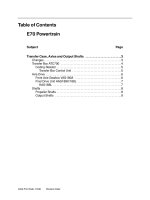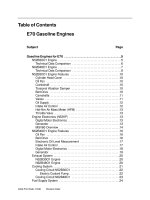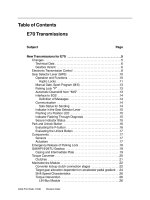D1854 02
Bạn đang xem bản rút gọn của tài liệu. Xem và tải ngay bản đầy đủ của tài liệu tại đây (28.08 KB, 3 trang )
Designation: D 1854 – 02
Standard Specification for
Jet-Fuel-Resistant Concrete Joint Sealer, Hot-Applied
Elastic Type1
This standard is issued under the fixed designation D 1854; the number immediately following the designation indicates the year of
original adoption or, in the case of revision, the year of last revision. A number in parentheses indicates the year of last reapproval. A
superscript epsilon (e) indicates an editorial change since the last revision or reapproval.
This standard has been approved for use by agencies of the Department of Defense.
peated cycles of expansion and contraction with temperature
changes, and that will not flow from the joint or be picked up
by vehicle tires at summer temperatures. These characteristics
shall be maintained in the presence or absence of jet fuel or
similar solvents. The material shall be capable of being brought
to a uniform pouring consistency suitable for completely filling
the joints without inclusion of large air holes or discontinuities,
and without damage to the material. On sawed joints, special
precautions and designs will be required to accept materials
covered by this specification.
1. Scope
1.1 This specification covers a jet-fuel-resistant concrete
joint sealer, of the hot-applied elastic type, intended for use in
sealing joints in concrete pavement in areas exposed to jet fuel
spillage. It may be found useful in industrial areas where
similar conditions exist (see Appendix X1).
1.2 The values stated in SI units are to be regarded as
standard. The values in parentheses are for information only.
The values stated in each system may not be exact equivalents;
therefore, each system shall be used independently of the other.
Combining values from the two systems may result in nonconformance to the standard.
1.3 This standard does not purport to address all of the
safety concerns, if any, associated with its use. It is the
responsibility of the user of this standard to establish appropriate safety and health practices and determine the applicability of regulatory limitations prior to use. Specific precaution
statements are given in Appendix X1.
4. Physical Requirements
4.1 Maximum Heating Temperature—This is the maximum
temperature to which the material may be heated and still
conform to all the requirements specified. It shall be at least
11°C (20°F) higher than the manufacturer’s recommended
pour point temperature and shall be provided the testing agency
prior to testing (see Appendix X1).
4.2 Nonimmersed Penetration, at 25 6 0.1°C (77 6 0.2°F)
and 150 g for 5 s shall be not more than 130.
4.3 Immersed Penetration, at 25 6 0.1°C (77 6 0.2°F) and
150 g for 5 s shall be not more than 155.
4.4 Penetration Difference, between nonimmersed and immersed penetrations shall be not more than 25.
4.5 Solubility—The gain or loss in weight on soaking in test
fuel shall be not more than 6 2.0 %, and there shall be no
apparent defects during the soaking period that will affect the
material as a sealing compound.
4.6 Flow, after 5 h at 60 6 1°C (140 6 2°F) shall be not
more than 30 mm.
4.7 Nonimmersed Bond— After three cycles at -18 6 1°C (0
6 2°F), not more than one specimen out of three shall develop
any crack, separation, or other openings in the sealing compound or between the sealing compound and the mortar blocks
that at any point is over 6 mm (1⁄4 in.) deep, measured
perpendicularly to the side of the sealing compound showing
the defect.
4.8 Fuel-Immersed Bond— After soaking in test fuel, as
specified, not more than one of the three specimens tested on
extension at -18 6 1°C (0 6 2°F) for three cycles shall show
complete cohesive failure of the material and the gross area of
bare concrete exposed on the face of any one block shall not
2. Referenced Documents
2.1 ASTM Standards:
D 5167 Practice for Melting of Hot-Applied Joint and
Crack Sealant and Filler for Evaluation2
D 5249 Specification for Backer Material for Use with
Cold- and Hot-Applied Joint Sealants in Portland Cement
Concrete and Asphalt Joints2
D 5329 Test Methods for Sealants and Fillers, Hot-Applied,
for Joints and Cracks in Asphaltic and Portland Cement
Concrete Pavements2
3. General Requirements
3.1 The joint sealer shall be composed of a mixture of
materials that will form a resilient and adhesive compound
capable of effectively sealing joints in concrete against the
infiltration of moisture and foreign material throughout re1
This specification is under the jurisdiction of ASTM Committee D04 on Road
and Paving Materials and is the direct responsibility of Subcommittee D04.33 on
Formed-In-Place Sealant for Joints and Cracks in Pavements.
Current edition approved July 10, 2002. Published September 2002. Originally
published as D 1854 – 61 T. Last previous edition D 1854 – 96.
2
Annual Book of ASTM Standards, Vol 04.03.
Copyright © ASTM International, 100 Barr Harbor Drive, PO Box C700, West Conshohocken, PA 19428-2959, United States.
1
D 1854 – 02
exceed an area of 1.6 cm2 (1⁄4 in.2).
Test Methods D 5329.
6.2.2 Immersed—Conduct the test in accordance with Test
Methods D 5329 except immerse the specimen for 48 h at a
temperature of 38 6 1°C (100 6 2°F).
6.3 Solubility—Test the specimen according to Test Methods D 5329.
6.4 Flow—Test the specimen at 60 6 1°C (140 6 2°F) for
5 h in accordance with Test Methods D 5329:
6.5 Bond:
6.5.1 Bond, Nonimmersed—Conduct the test in accordance
with Test Methods D 5329. The bond specimen shall be 25 6
0.1 mm (1.000 6 0.005 in.) in width, extended 50 %, and
tested at -18 6 1°C (0 6 2°F) for three cycles. Testing shall be
completed within 5 days of the start of testing.
6.6 Bond, Fuel-Immersed—The test shall be conducted in
accordance with Test Methods D 5329 and the procedures
listed in 6.5 except an immersion period of 48 6 2 h at 38 6
1°C (100 6 2°F) shall be used.
5. Sampling and Heating
5.1 Samples for testing shall each consist of not less than a
5-kg (10-lb) sample from each batch of the joint sealer. A batch
shall be considered as all finished material that was manufactured simultaneously or continuously as a unit between the
time of compounding and the time of packaging or placing in
shipping containers; each package or container shall be marked
properly to indicate clearly the batch of which it forms a part.
The material shall be sampled in accordance with Practice
D 5167. The sample portion for testing, which is added to and
heated in the melter, shall weigh approximately 1200 g.
5.2 Heating—The oil bath in the melter shall be to the
maximum heating temperature of the sealant being tested. Add
the sample according to the instructions provided in Practice
D 5167. After the sample has been added, the oil bath temperature may be increased to not more than 20°F (11°C) higher
than the maximum heating temperature, to raise the sealant
temperature to the maximum heating temperature within the
time required in Practice D 5167. Heating at the maximum
heating temperature shall continue until 90 min have elapsed
since the last segment was added to the melter and then the test
specimens shall be immediately poured.
7. Packaging and Marking
7.1 The joint sealant material shall be packaged in 5-gal
(18.9-L) sealed containers. Each container shall be clearly
marked with the name and address of the manufacturer, the
trade name of the sealant, specification designation, the manufacturer’s batch or lot number, recommended pouring temperature, safe heating temperature, and application instructions.
6. Test Methods
6.1 Specimen Curing— All specimens shall be cured at
standard laboratory atmospheric conditions specified in Test
Methods D 5329 for 24 6 2 h prior to beginning any testing.
6.2 Cone Penetration:
6.2.1 Nonimmersed— Conduct the test in accordance with
8. Keywords
8.1 hot-applied; jet-fuel; joint sealant; pavement; portland
cement concrete
APPENDIX
(Nonmandatory Information)
X1. PRECAUTIONS ON USE AND APPLICATION OF JET-FUEL-RESISTANT JOINT SEALER, HOT-POURED ELASTIC
TYPE
X1.1 Some, if not all, of the known materials conforming to
this specification may be damaged by heating to too high a
temperature, reheating, or by heating for too long a time. Care
should be exercised to secure equipment for heating and
application that is suitable for the purpose. The material should
be heated in a kettle or melter, constructed as a double boiler,
with the space between the inner and outer shells filled with oil
or other heat transfer medium. Positive temperature control,
mechanical agitation, and recirculating pumps should be provided. Other methods of indirect heating satisfactory to the
engineer may be used. Direct heating must not be used. As a
means of ascertaining whether or not the material covered by
this specification is being or has been damaged in the field as
a result of overheating, reheating, or prolonged heating, flow
panel specimens may be prepared periodically by drawing off
sealant directly from the melter-applicator during sealing
operations and then tested for flow according to Test Methods
D 5329 for materials covered by this specification. Flow in
excess of 30 mm would indicate damage to material caused by
improper heating procedures.
X1.2 Pavement joints in new construction for application of
material covered by this specification should be dry, clean of
all scale, dirt, dust, curing compound, and other foreign matter.
The sidewalls of the joint space to be sealed should then be
thoroughly sandblasted, blown clean of loose sand by highpressure air, and sealed by use of the melter-applicator described in X1.1.
X1.3 When material covered by this specification is used
for maintenance or resealing of joints that have previously
contained either similar or dissimilar sealieng material, it is
recommended that the joint be dry, cleaned thoroughly with a
plow, router, wire brush, concrete saw, or other suitable tool or
tools designed for the purpose of neatly cleaning pavement
joints. Loose material should be blown out. The sidewalls of
the joint space to be sealed should be thoroughly sandblasted,
2
D 1854 – 02
blown free of loose sand with high-pressure air, and then sealed
with material by use of the melter-applicator described in X1.1.
faces when the joint is open. Due to the elevated temperatures
of the application of material covered by this specification, care
should be taken in the selection of suitable backup materials.
The backer material shall meet the requirements of Specification D 5249.
X1.4 The use of a backup material or bond breaker in the
bottom of the joint to be filled with material covered by this
specification is recommended to control the depth of sealant
and achieve the desired shape factor, and to support the sealant
against indentation and sag. Backup materials and bond breakers should be compatible with the material, should not adhere
to the sealant, should be compressible without extruding the
sealant, and should recover to maintain contact with the joint
X1.5 Care should be practiced in the application of material
covered by this specification to avoid overfilling of the joint
space. Joints should be filled in a neat workmanlike manner
from flush to 3⁄16 in. (or 5 mm) below the adjacent pavement
surface.
ASTM International takes no position respecting the validity of any patent rights asserted in connection with any item mentioned
in this standard. Users of this standard are expressly advised that determination of the validity of any such patent rights, and the risk
of infringement of such rights, are entirely their own responsibility.
This standard is subject to revision at any time by the responsible technical committee and must be reviewed every five years and
if not revised, either reapproved or withdrawn. Your comments are invited either for revision of this standard or for additional standards
and should be addressed to ASTM International Headquarters. Your comments will receive careful consideration at a meeting of the
responsible technical committee, which you may attend. If you feel that your comments have not received a fair hearing you should
make your views known to the ASTM Committee on Standards, at the address shown below.
This standard is copyrighted by ASTM International, 100 Barr Harbor Drive, PO Box C700, West Conshohocken, PA 19428-2959,
United States. Individual reprints (single or multiple copies) of this standard may be obtained by contacting ASTM at the above
address or at 610-832-9585 (phone), 610-832-9555 (fax), or (e-mail); or through the ASTM website
(www.astm.org).
3









